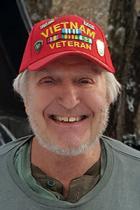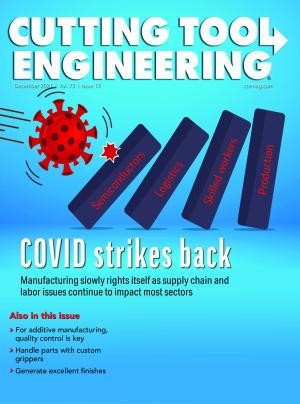At the machine shop, it is often necessary to know the temperature of a workpiece. In this column, I’ll describe a convenient way to take this temperature.
Because of thermal expansion, dimensions of solid materials change when temperature changes. This change of dimension is material-specific, so plastics expand more than metals, for example. A piece of mild steel that measures 100 mm (3.937") at 20 degrees Celsius (68 degrees Fahrenheit) will measure 100.08 mm (3.94") at 70 C (158 F). For 6061 aluminum, a 100 mm dimension will increase 0.11 mm (0.004") over 50 C (122 F), and for 6/6 nylon the increase in dimension is 0.45 mm (0.018"). As can be seen from these numbers, if you are making precision parts, you need to know the temperature of your workpieces. And it would be great if you could read the temperature of a turning workpiece on a lathe without having to touch it.
Temperature sensor companies have come to the rescue with sensor technology that is low-cost, accurate and very convenient to use. I’m talking about pistol grip infrared thermometers.
Because infrared light is invisible to human eyes, a laser projects a beam of visible light to aid data acquisition. Image courtesy of B. Taylor
A few companies make these gadgets with various features, so you have choices. Available from industrial and tool suppliers, the thermometers are self-contained and battery-powered. They work by reading the wavelength of infrared light emitted from a target. Because infrared light is invisible to human eyes, a laser projects a beam of visible light to aid data acquisition. You hold the thermometer like a pistol, pull the trigger to send a beam of light that makes a spot of light on a surface, aim at what you want to measure and read the temperature on the readout. (See the photograph.)
This brings us to my No. 1 feature: data storage. This means that the device records the temperature when the trigger is released and holds that temperature reading on the readout for a few seconds. Think about it: Without data storage, you simultaneously are aiming the laser beam at a possibly moving target and trying to read the readout, and when you release the trigger, the readout turns off. That’s kind of iffy. With data storage, you put the spot of light where you want it to be on the target, then you release the trigger. The spot disappears, and you read the temperature on the readout of what you were aiming at when the laser beam spot turned off. With data storage, your reading is more reliable. I recommend it.
Helpful feature No. 2 is the ability to read the temperature of shiny surfaces. If you make parts that are shiny from a high level of surface finish, you will want this option. Otherwise your temperature reading will be lower than the actual temperature of your target — sometimes way lower.
Feature No. 3 to discuss is temperature range. Some units read temperature high enough for those of us who do heat treating, but you’ll pay more money for that ability. Also, the thermometers all give readings in either Celsius or Fahrenheit. I perform a lot of custom lathe work, so I keep a thermometer in the tool rack beside the lathe. This is a timesaver.
Related Glossary Terms
- lathe
lathe
Turning machine capable of sawing, milling, grinding, gear-cutting, drilling, reaming, boring, threading, facing, chamfering, grooving, knurling, spinning, parting, necking, taper-cutting, and cam- and eccentric-cutting, as well as step- and straight-turning. Comes in a variety of forms, ranging from manual to semiautomatic to fully automatic, with major types being engine lathes, turning and contouring lathes, turret lathes and numerical-control lathes. The engine lathe consists of a headstock and spindle, tailstock, bed, carriage (complete with apron) and cross slides. Features include gear- (speed) and feed-selector levers, toolpost, compound rest, lead screw and reversing lead screw, threading dial and rapid-traverse lever. Special lathe types include through-the-spindle, camshaft and crankshaft, brake drum and rotor, spinning and gun-barrel machines. Toolroom and bench lathes are used for precision work; the former for tool-and-die work and similar tasks, the latter for small workpieces (instruments, watches), normally without a power feed. Models are typically designated according to their “swing,” or the largest-diameter workpiece that can be rotated; bed length, or the distance between centers; and horsepower generated. See turning machine.
- turning
turning
Workpiece is held in a chuck, mounted on a face plate or secured between centers and rotated while a cutting tool, normally a single-point tool, is fed into it along its periphery or across its end or face. Takes the form of straight turning (cutting along the periphery of the workpiece); taper turning (creating a taper); step turning (turning different-size diameters on the same work); chamfering (beveling an edge or shoulder); facing (cutting on an end); turning threads (usually external but can be internal); roughing (high-volume metal removal); and finishing (final light cuts). Performed on lathes, turning centers, chucking machines, automatic screw machines and similar machines.


